#french folklore
Explore tagged Tumblr posts
Note

Perhaps… a new emblem would be good for you, Jaune
Jaune: But... I'm not a wolf.
Jaune: Unless...
--------------------------------------------------
Le Loup-Garou
Ruby: On the one hand, he's decimating the Grimm population in his nightly rampages.
Ruby: On the other hand, he's almost killed a dozen people and we had to distract him to get him to attack more Grimm.
Ruby: I tried to cut him, but he's just too fast.
Ruby: ...Part of me thinks it's because we held hands the night before Egg Day.
--------------------------------------------------
La Bête du Gévaudan
Weiss: Thankfully, we were able to subdue him before he could cause too much trouble.
Weiss: It costed us about 6.2 million lien in property damage, three squadrons of Atlas' finest, and about 3.4% of Remnant's supply of dust. But, on the other hand, a number of Salem's secret agents were found and killed, so silver-lining, I guess.
Weiss: ...What? What do you mean it's not Jaune? WHAT DO YOU MEAN THE ATTACKS ARE STILL HAPPENING?!
--------------------------------------------------
Le Loup Blanc
Blake: Oh, we're getting invited to a wedding.
Yang: Really? Who's getting hitched?
Blake: Uh... It says Arc and Schnee.
Yang: Oh, so Weiss and Jaune finally got together, huh?
Blake: I don't think it's Jaune or Weiss.
Yang: Wha...
[Photo of Bride Winter beside Wolf Jaune]
#rwby#jaune arc#ruby rose#weiss schnee#blake belladonna#yang xiao long#winter schnee#winter's knight#winter knight#wolf jaune#french folklore#french folktales
91 notes
·
View notes
Text
So I've seen people in the fandom do it for their country, I loved so much the idea I did the same (i'm very influencable).
(Based on the lore/maps of the webcomic "Stand Still Stay Silent")
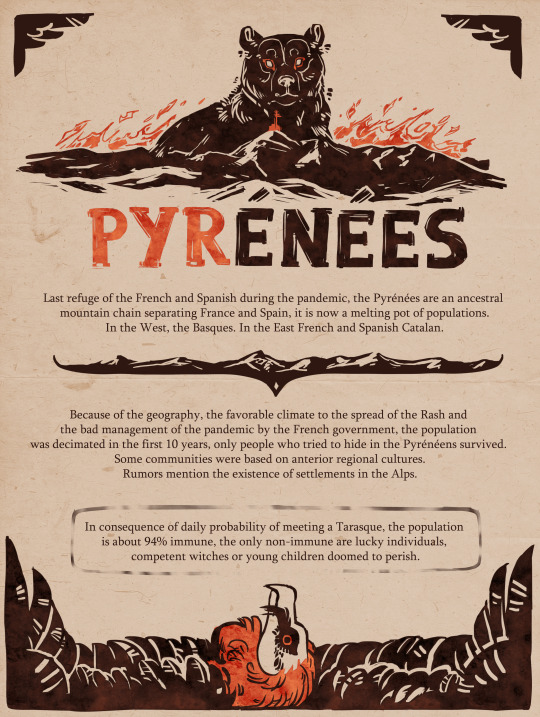
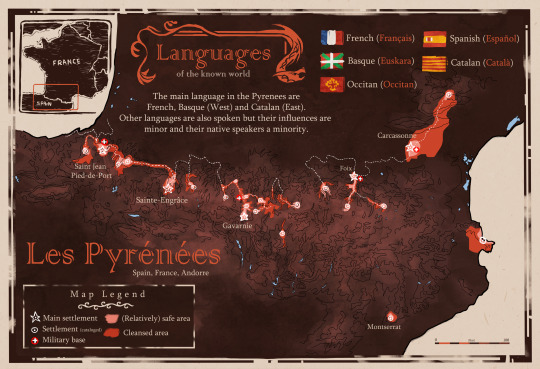
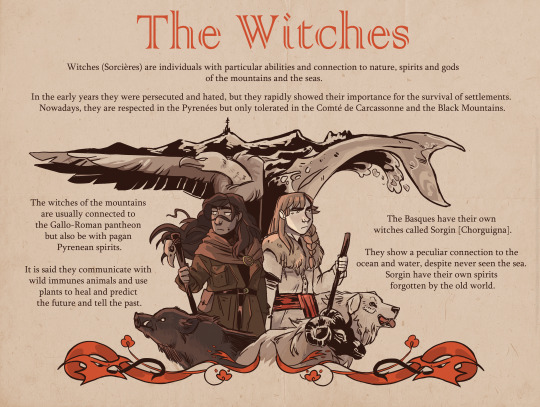

Even if I did know it could not fit the canon, I tried my best to do the more accurate (non-canon) lore for french territory.
I will maybe do a part 2 but not now, I will talk more about the infected and the Basques language.
The Tarasques are the french equivalent of the Trolls, I didn't have the energy to add other pages of information. (one day maybe)
I also wanted to mention the Dahu in the type of infected beast. (Yes there are Dahus, and that's is the best thing to know about infected beast, THERE ARE DAHUS INFECTED BEAST PEOPLE.)
______________________________________________________________
(Also can't spell in english so that's not very well written lol)
(Please note I'm just doing this for fun and it's a very rough/sketchy idea and I didn't take time to well adapt everything or even have a stylise coherence)
#my art#my artwork#sssscomic#stand still stay silent#Stand still stay silent comic#stand still stay silent fanart#fanart#Summer bear art#webcomic fanart#digital art#fanmade#fanmade map#artists on tumblr#pyrenees mountains#french folklore#fun fact#did you know until 2015 Icelanders could murder Basques legally#well now you know#it's because of whales#I passed to much time on this stuff#I think I hyperfocus on the task and forgot time exist#Half of the clean area are places I've been and the other is random#Gavarnie is very nice#love this place#Also#so sorry if there are any mistakes in English#I can't spell lol#(neither in french and english)#love dyslexia#and my dumb ass
247 notes
·
View notes
Text
I was thinking about the difference between the British "fairy" and the French "fée", and suddenly the perfect comparison struck me.
The "fairy" from British folklore is basically Guillermo del Toro's take on the fair folk, trolls, goblins and other fairies in his movies, from "Pan's Labyrinth" to "Hellboy II". You know, all those weird monsters and bizarre critters with strange laws and customs, living half-hidden from humans, and coming in all sorts of shapes and sizes and sub-species and whatnot. Almost European yokai.
But the "fée" of French legend and literature? The fées are basically Tolkien's Elves. Except they are all female (or mostly female).
Because what is a "fée"? A fée is a woman taller and more beautiful than regular human beings. She is a woman who knows very advanced crafts and sciences, and wields mysterious unexplained powers. She is a woman who lives in fabulous, strange and magical places. She is a woman with a natural knowledge or foresight of the past and the future, and who can appear and disappear without being seen. Galadriel as she appears in The Lord of the Rings is basically the best example I can use when trying to explain to someone what a "fée" in French folklore and culture actually is.
(As a reminder: the fées of France are mostly represented by the Otherwordly Ladies of the Arthurian literature - Morgane, Viviane, bunch of unnamed ladies - or by the fairy godmothers of Perrault or d'Aulnoy's fairytales, to give you an idea of how they differ from the traditional "fae" or "fair folk". All female, and more unified, and so human-like they can pass of or be taken for humans. The "fées" are cultural descendants of the nymphs and goddesses and oracles/priestesses of Greco-Roman-Germanic-Gallic mythologies. That's why they are so easily confused with witches when they turn evil, and when Christianity arose most fées were replaced by the figure of the Virgin Mary, the most famous "magical beautiful otherwordly woman" of the religion)
#fairies#fée#french folklore#french legends#european folklore#fairy#fair folk#tolkien's elves#elves#fées
145 notes
·
View notes
Text
On the belief in Werewolves in the northern Alps. (part 1) Contemporary documents speak of "thousands of members" in the packs that crossed and/or lived in the Northern Alps. The damage was worse than one can imagine among children. A population of peasants that, moreover, often lived quite isolated due to the difficulties from the mountainous terrain.
From the 16th century, in official documents and on many occasions, we witness a "terminological confusion" : the narrator himself does not seem to make a difference between the two semantic spaces : wolves and werewolves.
It is not clear where the boundary lies between the two "beings" that both evoke a feeling close to terror.
--
- Excerpt from a 16th century document, written by a local notary, in the small village of Saint Antoine : " (…) shortly after sunset, the wolf went to take from a child who was walking under the trellis ; while his mother was feeding a smaller one, the beast carried him off without anyone being able to help him. His remains were never found. Some time before, a werewolf had taken another child from the house of A. Some time later, the mother of this child, saw the wolf again advancing towards the village at nightfall, and shouted "Wolf! Wolf!", the wolf jumped at her throat. The woman had already been dead for a long time when help arrived."
The same document relates several times that the wolves that attack have already devoured the dogs that are supposed to protect the farms.
--
[Extract arranged by me from "Les loups garous en Dauphiné et en Savoie", Charles Joisten, Robert Chanaud, Alice Joisten, revue Persée.]
17 notes
·
View notes
Text
Of a Wolf and a Gift
A folktale from Mégevette, France
One day, in the village of Cez, a husband and wife were just taking their baking of bread out of the great communal oven, when an animal appeared and sat down, looking at them. It looked like a dog, bit its head was far more like wolf’s and there was hunger in its eyes. The man took pity on the starving beast and tore a piece off a freshly baked loaf to offer it to them, but his wife prevented him. She took up a stick and shouted at the creature: “Get away you stupid thing! We barely have enough to feed ourselves!” And the animal fled.
Winter came, and because there was no other work to be had in that season, the husband did as he usually did and went off as a travelling merchant. He sold a great deal of his merchandise to a family in Alsace and to his surprise they told him that they knew Mégevette and were acquainted with his wife.
“She is the kindest, most generous lady who ever lived,” said the grandmother of the family. “Please take back this gift for her, to wear on Sundays.” And she handed the man a fine vest, knitted from the softest wool.
When the husband returned to his wife he presented her with the gift at once, but to his surprise she regarded it with great suspicion. “I know no one in Alsace who would give me a gift,” she declared and before her husband could say another word she took the vest and flung it out of the window.
It caught on a branch of the cherry tree beside the house and there it remained. But the following year, that tree did not bear fruit. Little by little it wilted and withered, until it eventually died. And the same would have happened to that woman, if she had worn the vest that her husband brought back for her, because the person who sent it to her was the very werewolf she had chased away.
Translated and retold from the French given in Joisten & Chanaud’s Les loups-garous en Savoie et Dauphiné; tale 20 (told by Louis Bron in 1965), which is a variant of tale 22 “Le don au loup” (told by Gustave Chevallier in 1965).
95 notes
·
View notes
Note
Are there any fae-like creatures in french myths?
I know about the story of a giant black wolf that terrorized France back in the day, but that’s all I can remember.
Legends and stories including wolves are in fact really widespread in european culture since middle age ! But yeah the most well known in France is the Beast of Gévaudan which was described as massive ! (and the one from Le petit chaperon rouge/Little red riding hood)

Concerning other creatures and fairies/faes in french legends and stories, we do have
Mélusine : fairies mentioned a bit everywhere in France, they are mostly described as women with a scaly tail lower body and are sometimes associated with mermaids or vouivres. (far from how they look like in genshin impact)
Vouivre : not to be mistaken with wyverns, vouivres are creatures described as snakes with bat wings, sometimes they are depicted having rear legs and wings (and they look very goofy like that imo). These creatures can be aquatic and in some descriptions, possess a big jewel on their forehead.
Tarasque : a creature from provencal legends, which lived in a swamp near Tarascon and terrorized and ate people. It's most popular description was of a big creature with a spiked turtle shell, six bear legs, horse ears, bull chest, lion head, a human face and a twisted tail. Legend says Ste. Marthe tamed the beast. (I swear they were just being attacked by bowser this is the same creature)
These are the one I depicted roughly in the pic above but there are many more creatures depending on the different regions of France ! (There's a lot of fairies and fantasy like creature in stories from bretagne/brittany) Some others that I find either fun or cool are :
Meneurs de loup : which translates to wolf leaders are people told to be able to talk to wolves and even transform into one, either because they are werewolves or they made a pact with the devil. (it's kinda giving spice and wolf vibes and I love that story sm)
Jambe crue/Came-cruse : Roaming in the Pyrénées at night, this thing is a single leg with an eye on the knee that eats people and runs very fast. (Idk why this one is so funny to me but oddly terrifying as well)
#french folklore#we also have fairies and mages that come from arthurian legends because i don't know how/why but some of the stories took place in france#it is said in France that Merlin used to live at some point in the forest of Brocéliande that is said to be either in brittany or normandy?#and there's that whole lancelot du lac thing as well#idk if I can choose a favorite creature in general french or not but kelpies are cool and rusalkas as well#medieval unicorns that look more like goats are dope as well#most man eating beings or creatures that use appearances to lure people are soo cool tbh#katsura otoko is an example from japanese folklore guy on the moon that feeds on your life essence the more you stare at the moon#if i recall it right..#Oh ! and Powerwolf did a song in french about beast of gevaudan ! if anyone likes power metal#the whole band’s aesthetic is priest werewolves idk why but hey half of it is right in my alley
83 notes
·
View notes
Text
Légendes rustiques by George Sand, completed English translation

Original French at Project Gutenberg
Les Légendes rustiques is a collection of twelve creepy French folk legends gathered up and written down by George Sand and illustrated by her son, Maurice Sand, published in 1858. These stories were collected in the Berry region, but there are connections made to legends from Brittany and Normandy as well.
I came across a mention of the Rustic Legends a few years ago and realized there was no official English translation available, despite that George Sand is a very famous author. It turns out, Sand was such a prolific writer that much of her work has never been translated into English. I ordered a "translation" from Amazon and was disappointed to find that someone had just run the text through translation software without any editing or providing any cultural context. It was unreadable and I threw it in the trash.
I asked some fandom friends if they would be interested in trying to translate all twelve legends into English on our own. It has been a few years and each story has had several revisions and rounds of editing. This was a challenging translation project - there are many words in archaic French or not in French at all. Thanks to everyone who helped - I am really proud of the results here.
The purpose of this project is simply to make these twelve legends accesible to an English-reading audience. They have been available in the original French at Project Gutenberg for a long time. Use this post as a table of contents - each line will take you to a new story published on Tumblr. Sometimes they are creepy, they are often funny, and Sand's rambling style is cozy, making you feel like she is sitting right across a candle from you, telling you a story she once heard from someone else, a long time ago. Enjoy!
Introduction
1. Les Pierres-Sottes
2. Les Demoiselles
3. Les Laveuses de nuit
4. La Grand’Bête
5. Les Trois Hommes de Pierre
6. Le Follet d’Ep-Nell
7. Le Casseu’ de Bois
8. Le Meneu’ de Loups
9. Le Lupeux
10. Le Moine des Étangs-Brisses
11. Les Flambettes
12. Lubins et Lupins
#légendes rustiques#george sand#maurice sand#french literature#in translation#folklore#rustic legends#french folklore#translation project#bretagne#brittany#normandie#normandy#berry
27 notes
·
View notes
Text
French Folklore of the Devil

Where do we find Him?
CLVII • THE INCANTATION OF THE FROG
''According to a belief in Lower Brittany, to get in touch with the Devil, you must take a green frog on the day of the full moon and place it on an anthill while saying:
''Without fear or dread
Green frog continue on your way
Meet the Devil
So that he brings me a little gold
And that I have the means
To stay forever without working.''
Claude Seignolle • The gospels of the Devil
#the Devil#folkloric devil#le diable#french folklore#french folklore devil#meet the devil#green frog#frogs in french folklore#anthill#witchcraft#french witchcraft#french witchcraft folklore#claude seignolle#the gospels of the devil#les évangiles du Diable#legends#traditional witchcraft#witch folklore#witchcraft folklore#witch lore#folkloric witchcraft#brittany#france#full moon
24 notes
·
View notes
Text










Medieval Women Week || Favorite fictional medieval woman ↬ Melusine
In this, the novel follows in a long tradition of artistic and scholarly fascination for the puzzling figure who is Mélusine. Indeed, there has been much critical debate on her true nature: some scholars see Mélusine as a benevolent fairy lover, some categorize her as a foundational ancestor or mother goddess figure, whilst others argue that her serpentine nature links her with demons, the Eden serpent or the monstrous races of sirens, undines, and succubi. However, Mélusine’s character is so remarkably ambiguous and multifaceted that it is misleading to attempt to define her by one particular characteristic alone. Just as Mélusine’s body continually changes – from human to hybrid and eventually to animal – so does her character, allowing for a multitude of possible readings. Undoubtedly, it is this flexibility and open-endedness which lies at the root of the ongoing fascination with the Mélusine story and with her hybrid body. Nowadays, Mélusine’s monstrous figure not only appears in a postmodern novel such as Possession but is also found in video games, fantasy literature, graphic novels, gothic metal songs, and the logo of a well-known coffee chain. — The Mélusine Romance in Medieval Europe: Translation, Circulation, and Material Contexts by Lydia Zeldenrust
#medievalwomenweek#melusine#house of plantagenet#house of lusignan#breton mythology#french folklore#house of luxembourg#mythology and folklore#medieval
24 notes
·
View notes
Text
Fairytales in BD: La Cuisine des Ogres

Have you ever wondered what a Ghibli movie made by Guillermo del Toro would look like? Wonder no further: this comic is for you!
"The Ogres' Kitchen" is a recently-started BD series. Like... very very recently. As in, the first volume, "Trois-fois-morte" (Three-times-dead) was published just a few months ago.
This BD takes place within a fictional version of "The Cat's Teeth", an actual mountain of France. A little girl, part of a gang of street urchins, gets kidnapped by a bogeyman one night, and brings them to the "secret side" of the Cat's Teeth - which turns out to be the realm of an entire community of ogres... She survives the monsters' appetites by undergoing three almost-lethal ordeal (hence her nickname of "Three-Times-Dead") and starts a new life among the lower-class of the mountain's fae-folks - the fauns, satyrs, elves and dwarves in charge of the cooking chores of the giants, witches and other bogeypeople straight out of French legends...








#fairytales in bd#fairytale comics#french comics#la cuisine des ogres#french folklore#dark fairytale#fairytale bd
24 notes
·
View notes
Text

#my art#rough doodles#mélusine#french legend#french folklore#french side of tumblr#medieval art#medieval
8 notes
·
View notes
Text
also this amelia project episode made me think of how people often talk about how grim and depressing the original versions of fairytales actually are and it's interesting how that seemed perfectly appropriate and good for children to learn at a young age
and it reminded me, when I was a child, my mom used to sing me an old but pretty well known song about a kid who got beaten to death by her mother, and I used to sing along ! it's an actual song from my mother's childhood that they used to get kids to sing at summer camp in the 60's -
it's called l'enfant de la misère by Berthe Sylva, and I translated the end from french to english for you :


youtube
so yeah, not very fun, but it did seem perfectly normal at the time and my mother never thought twice about it, tho I have to admit this is quite the uncommon experience maybe because my mother is from a slightly older generation than most people my age's parents
this is an official french folklore post ! :D
7 notes
·
View notes
Text
When talking about the French Père Noël, we have to talk about a variation of his that is NOT Saint Nicolas. I already evoked several times the various names of the Christmas gift-giver (Père Noël, Bonhomme Noël) and how he was tied to the gift-giver of the beginning of December (Saint Nicolas). But there was also a gift-giver at the end of the year... A gift giver of New Year's Eve or New Year's Day. Remember when I talked before of "Père Etrennes" or "Bonhomme Etrennes"? The "étrennes" are a French tradition whose closer English equivalent would be the word "handsel/hansel".
The étrennes were originally gifts that were given to friends, family and other next of kind at the beginning of January to celebrate New Year. Today the tradition has massively evolved - étrennes are given at the end of December rather than early January, it is money rather than gifts, and they are now a gesture of kindness destined to those employed by you or that work for the community (the fireman, the mailman, the housekeeper, the garbage collector...). But despite this evolution, "étrennes" stayed associated with an appreciative and kind giving gesture around New Year. And where there's gifts, there's a gift-giver...
This website presents us with this picture, a 1930s postcard, and says it could be the Père Fouettard... or the Père Janvier (Father January).
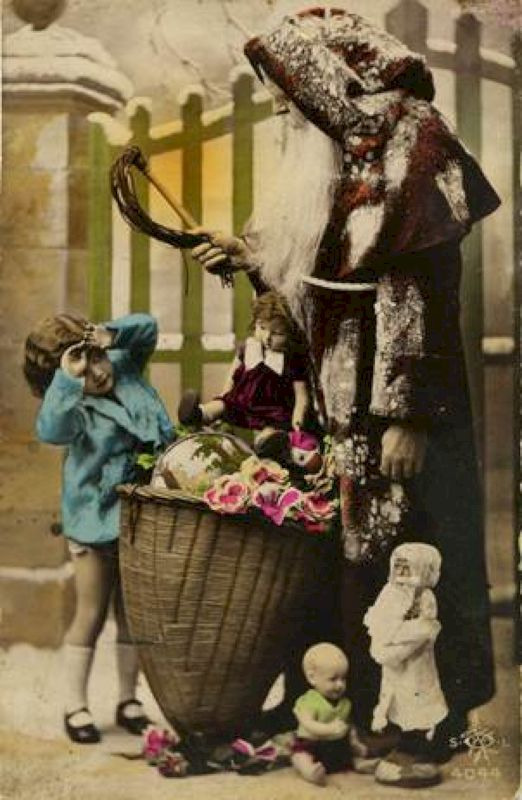
In the French region of Bourgogne, there was no "Père Noël" or Father Christmas in the early 20th century: rather there was Father January, Père Janvier, who came around New Year to give the étrennes - the gifts. By the 1930s the tradition was still very strong, especially in the Morvan and the Nivernais - as well as in the Nord-Pas-de-Calais (Father January had moved to the North of France when in the mid 19th century a lot of people from the Morvan went to work in the mines there). And from the 1930s to the 1960s, in all those areas, there was a transition from Père Janvier to Père Noël, resulting in the children of those three decades to have the benefit of two mysterious supernatural benefactors coming at the end of the year... Before Père Janvier stopped coming by the 60s, definitively replaced by Père Noël (the Americanized one of course, remember post-50s Père Noël is just Santa Claus with a different name).
This other website goes into more details about the world of Père Janvier - or rather of Bonhomme Janvier (Old Man January/The January Man).

Le Père Janvier, or Bonhomme Janvier, existed for a very long time in the tradition of the Berry region, before the Père Noël was even introduced. Not just in the Berry, but also in the Morvan and in all of Bourgogne - and even in many others areas of France! Lyon knew of him, the Haute Marne, Saône-et-Loire, Ardèche - they all had records of Father January, this white-bearded old man that brought gifts to children on the 1st of January. In the Berry region, the Père Janvier usually left sweets inside in their slippers for New Years Day, and on New Years Eve chimneys were carefully cleaned up so he could enter the house unsoiled.
And just like Saint Nicolas or Père Noël, Bonhomme Janvier ALSO was followed by Père Fouettard, with his wicker basket filled with "martinets" (beating/whipping tools for naughty children):

While sometimes Bonhomme Janvier brought many toys or sweets (found in the children's shoes or "sabots" placed by the chimney), there was one tradition according to which Janvier only ever brought one item per person, not more - with sometimes a sweet or candy to accompany it (often it was a pipe made of sugar). Tradition claimed it was because Père Janvier hated greedy or gluttonous children - but more realistically, it was probably just a tale invented by poor families to justify the lack of gifts...
And of course, as Père Noël arrived in the 20th century, Bonhomme Janvier slowly faded away...

#french folklore#christmas lore#père janvier#father january#father christmas#new years eve#new years day#new year folklore#père noël#père fouettard
93 notes
·
View notes
Text
On the belief in werewolves in the northern Alps (part 2.)
In this distribution of beliefs, the phenomenon that we note from the outset (…) is an opposition of geographical character : lowlands / mountains. Opposition that corresponds to a notable difference in themes, both in form and in substance.
Schematically, in the mountainous regions, the stories and the belief in werewolves are supported by structured and constructed stories, with recurring themes: typical stories with very traditional content.
In the plain, the majority of the stories, of much less elaborate forms, convey, by their very clear anti-feudal side, the affirmation of an exploitation of the people by the lords and the clergy.
-
[Extract taken from "Les loups garous en Dauphiné et en Savoie", Charles Joisten, Robert Chanaud, Alice Joisten, revue Persée.]
7 notes
·
View notes
Photo
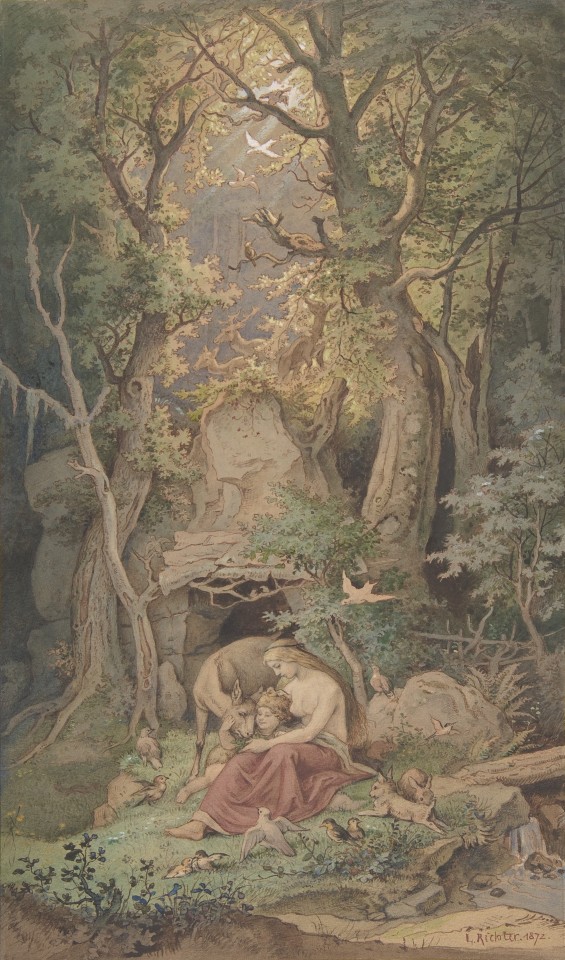
Genoveva, Ludwig Richter, 1820-84
Watercolor on paper 12 ¼ x 7 ¼ in. (31.1 x 18.4 cm) The Metropolitan Museum of Art, New York City, NY, USA
#art#painting#ludwig richter#folklore#19th century#watercolor#1820s#the met#medieval folklore#dutch folklore#belgian folklore#french folklore#german
70 notes
·
View notes
Text
the Red Man of Tuileries

It was late in May of 1871 that a motley group of workers, under the orders of Jules Bergeret, took barrels of pitch, tar and other accelerators and marched up the steps of the Palace of Tuileries. All day long, fighting had raged in front of the grand building as the French army fought the Paris Commune. What had started off as a dream for a better world, or at least a better Paris, only a few short months ago was coming to an end and like hell were the men and women of the Paris Commune going to retreat without burning everything, and everyone, to the ground behind them. Into the beautiful hallways that had once housed royalty and ambassadors from around the world, marched the team of workmen, painting everything with turpentine, petroleum and tar as they swept through, moving from carved room to carved room. In the center dome of the palace, more men laid explosives. It was evening and the growing shadows stretched long and flickering in the approaching darkness of the night. Breaking up into smaller and smaller groups to reach each of the rooms, the workers heard footsteps on the stone floors behind them that moved when they weren't, echoes, dry and dusty that skipped strangely through the hollows of the rooms they roamed through. More than one of them caught glimpses from the corners of their eyes, right on the edge of their vision, the flicker of red cloth, dark as old blood, there and gone in a blink. The evening air was cool and the work had the sweat trickling down their backs but that didn't account for all of the chills that went down their spines. Jobs finished, they tried not to make it obvious how quickly they hurried out of the empty palace, tried not to show too much of their relief when they were once again outside of its walls, surrounded by their companions. The word was given, the first torch laid to beautifully decorated walls. Fire sprang up, as if it had always been there just waiting for this moment and engulfed the once majestic Palace of Tuileries, consuming it as if it were made of paper instead of stone. The fire burned for two days and if anyone saw a red dancing figure of a man watching them from its smoke and flames, they didn't share the story with anyone else. The Paris Commune was dead and its members had other, more immediate problems, like surviving, to deal with. The Red Man of Tuileries had, finally, stood watch over the last tragedy of Tuileries.
But not the first.
The Palace of Tuileries was built in 1564 by Catherine de' Medici, after her husband, Henry II, king of France, died. It was going to be her own personal residence, as a royal widow, and no expense was spared toward her future comfort. This was not to be the case however.
According to some legends, a man she employed named, aptly, either Jean the Skinner or Jean the Flayer, who carried out political assassinations for her found out a bit too much for his employer's comfort and Catherine had her assassin assassinated. When his killer went back into the Tuileries garden to retrieve the body for burial, it was missing however - and the Palace of Tuileries had a new ghost, one that appeared just before each new royal disaster.
In another branch of the same story, the Red Man had never served Catherine at all. When the palace had finally been nearing completion, Catherine, ready to move in and visiting for last minute decisions, had found someone else already living there. A small man, dressed all in red, cloven hooves for feet optional. Catherine wasn't about to share her home with someone like that and she left, never to return.
A civil war between the Protestants and Catholics that burst out and engulfed Paris in 1588 might have had something to do with that as well. Or perhaps it was just the first time the Red Man would reveal his purpose.
No matter where he came from, from that point on, the Red Man of Tuileries would show up just before disasters, glimpsed briefly in the halls of the palace only to disappear when noticed.
The Red Man was spotted in the halls of Tuileries just before Henry IV was assassinated in 1610. Several of Marie Antoinette's ladies were reported to have seen him only days before the August 10th Insurrection in 1792. He was spotted again right before Louis XVI's execution in 1793. The last recorded mention of the Red Man happened only days before the burning of the Tuileries in 1871, when the custodian of the place saw the figure standing in a pose of deep sorrow, not once, but twice in the same night before he vanished.
The Red Man's most talked about appearance however involved Napoleon Bonaparte. Stepping outside of his usual job of being a harbinger of doom, as well as actually leaving Tuileries for the first time, the Red Man apparently appeared to Napoleon three times. The first time was said to be just before the Battle of the Pyramids while France was invading Egypt in 1798. Legends say that the Red Man promised Napoleon ten years of success, later to be buffered by an additional five, but at the end of that time period, Napoleon would never again be successful in military matters. The Red Man was said to have showed up after the Battle of Wagram in 1809 to warn Napoleon against setting foot in Russia. In January of 1814 the Red Man appeared one last time to Napoleon, warning him that his time was running out. That was the last time legend says the Red Man appeared to Napoleon and it was also, shortly afterward, the end of Napoleon's rein.
The Red Man of Napoleon's contract and the Red Man of Tuileries seem to serve very different purposes and so I wonder if the stories surrounding the two became a mesh of two different 'red men with supernatural powers hanging around French leadership'. Rumors said that Napoleon often spoke of a 'red star' he was under that led him to victory. Either way, the Red Man of Tuileries hasn't been seen since the fire that gutted the palace in 1871. Maybe the destruction of the palace finally laid him to rest. Or maybe he's waiting for royalty to return to France so he can again lurk in their hallways, waiting to warn of danger and, perhaps, offer bargains of power to those egotistical enough to accept.
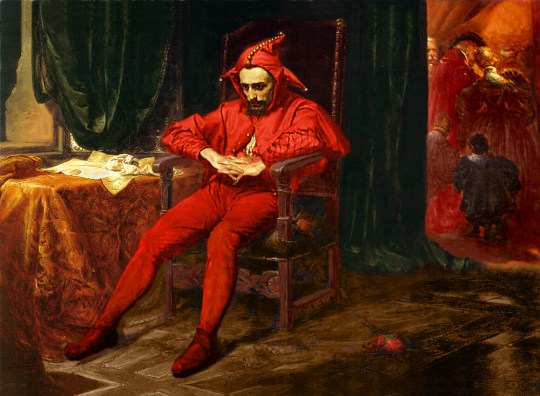
#tuileries#palace of tuileries#napoleon#superstition#folklore#red man#france#french folklore#marie antoinette#catherine de medici#burning of tuileries#ghost stories#harbinger#cryptid
27 notes
·
View notes